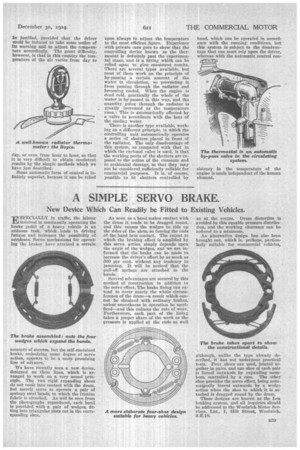A SIMPLE SERVO BRAKE.
Page 23

If you've noticed an error in this article please click here to report it so we can fix it.
• New Device Which Can Readily be Fitted to Existing Vehicles.
MI SPECIALLY in traffic, the labour
involved in continually .operating the brake pedal of a heavy vehicle is an arduous task, which. leads to driving fatigue and increases the possibility of accidents. Servo mechanisms for operating the brakes have attained a certain,
measure of success, but the self-contained brake, embodying some degree of servo action, appears to be a more promising line of advance.
We have recently seen a new device, designed on these lines, which is arranged to work on a very sound principle. The two rigid expanding shoes do not come into contact with the drum, but merely servo to operate a pair of springy steel bands, to which the friction fabric is attached. As will be seen from the photographs reproduced, each band is provided with a pair of wedges, fitting into triangular slots cut in the corresponding shoe. As soon as•tt band makes contact with the drum it tends to be dragged round, and this causes the wedges to ride up the sides of the slots, so forcing the ends of the band into contact. The extent to which the braking effect is amplified by this servo action. simply depends upon the angle of the Wedges, and we are informed that the brake can be made to increase the driver's effort by as much as 300 per cent, without any tendency to jamming. It will be noticed that the pull-off springs are attached to the bands.
Several advantages are secured by this method of construction in addition to the servo effect. The brake lining can extend to cover nearly the whole circumference of the drum—a result which cannot be obtained with ordinary brakes, unless smoothness in operation be sacrificed—and this reduces the rate of wear. Furthermore, each part of the lining takes a proper share of the work as the pressure is applied at the ends as well
• as at the centre. Drum distorticin is avoided by this equable pressure distribution, and the working clearance can be reduced to a minimum.
An alternative design has also been brought out, which is, perhaps, particularly suitable for commercial vehicles,
although, unlike the type already described, it has not -undergone practical tests. Four shoes are used, jointed together in pairs, and one shoe of each pair is forced outwards by expanding members, controlled by a cam. The other shoe provides the servo effect, being automatically forced outwards by a wedge action when the shoe to which it is attached is dragged round by the drum.
These designs are known as the Len braking system, and all inquiries. should be addressed to the Woolwich Motor Services, Ltd., 3., Hill Street, Woolwich,






























